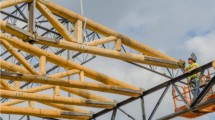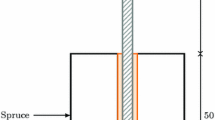Abstract
Connections for timber structures using concealed bonded-in rods offer one possible solution to the development of more efficient joining methods. However the importance of certain basic joint characteristics, and the influence of adhesive type and properties, are not yet fully understood and as such design criteria are lacking. This paper describes a comprehensive experimental and numerical investigation into the fundamental material and joint geometry characteristics of rods bonded in to timber. The adhesive type and performance are both considered, along with test configuration and joint parameters that included rod embedment length, rod diameter, annular bondline thickness, multiple rods and rod spacing. A novel approach that involved end-profiling of the bond area was also investigated. It was found that epoxy adhesives out-performed all other types investigated, and pull-out strengths can be significantly improved through careful selection and optimisation of the joint geometry.
Résumé
L'assemblage des structures en bois de construction au moyen de tiges en acier enfoncées à l'intérieur du bois offre une solution possible à l'élaboration de méthodes plus efficaces pour relier ces types de structures. Cependant, l'importance de certaines caractéristiques de base des joints et l'influence du type et des propriétés de l'adhésif ne sont pas encore entièrement assimilées: il manque des critères de conception. Cet article décrit une recherche expérimentale et numérique sur les caractéristiques foundamentales des matériaux ainsi que sur la géométrie d'assemblage des tiges en acier fixées au bois de construction. Le type et la performance de l'adhésif ont été considérés, ainsi que le mode d'essai (tiges simple, multiples et espacement des tiges multiples) et les paramètres des joints comprenant: le diamètre, la longueur d'enfoncement et l'épaisseur annulaire d'adhérence de la tige. Une nouvelle approche qui mettait en application une méthode visant à profiler l'aire d'adhérence des tiges a également été étudiée. On a constaté que les adhésifs époxydes ont surpassé tous les autres types étudiés, et leur résistance peut être améliorée de façon significative par la sélection et l'optimisation de la géométrie d'assemblage.
Similar content being viewed by others
References
Timber 2005—A research and innovation strategy for timber in construction. UK Department of the Environment, Transport and Regions, London, Construction Sponsorship Directorate (1996).
Milner, M. W. and Bainbridge, R. J., ‘New opportunities for timber engineering’,The Structural Engineer 75 (16), (1997) 278–282.
Paw, C., Rattray, J. C. and Robertson, A. M., ‘Building with roundwood 1’,Farm. Building Progress (99), (January 1990) 7–11.
Burton, R., Dickinson, M. and Harris, R., ‘The use of round-wood thinnings in buildings—a case study’,Building Research and Information 26 (2) (1998) 76–93.
TRADA. ‘Resin-bonded repair systems for structural timber’, TRADA wood information sheet. Section 4, Sheet 22, Timber Research and Development Association (TRADA), High Wycombe, UK (1995).
Lee, N. K., Mayfield, B. and Snell, C., ‘Resin anchors in concrete, Part 1’,Civil Engineering (April 1980) 35–41.
Lee, N. K., Mayfield, B. and Snell, C., ‘Resin anchors in concrete, Part 2’Civil Engineering (June 1980) 47–53.
Zavaliaris, K. D., Kollias, S. and Speare, P. R. S., ‘An experimental study of adhesively bonded anchorages in concrete’,Magazine of Concrete Research 48 (175) (1996) 79–93.
Riberholt, H. and Spoer, P., ‘Design of the inglued rods that are used for the wingblade root section on Nibemolle-B’. Serie R-Danmarks Tekniske Højskole, Afdelingen for Bærende Konstructioner (Building Department), 167 (1983).
Mettem, C. J. and Davis, G., ‘Resin bonded repair systems for structural timber’,Construction Repair (March/April 1996).
Zaboklicki, A. and Gebski, M., ‘Continuity of wooden beams as a bonded method of reinforcement and preservation of timber structures at monumental buildings’,Int. Series on Advanced Architecture 3 (1997) 541–546.
Wheeler, A. S. and Hutchinson, A. R. ‘Resin repairs to timber structures’,Int. J. Adhesion and Adhesives 18 (1) (1998) 1–13.
Kangas, J., ‘Joints of glulam structures based on glued-in ribbed steel rods’, VTT Publications 196. Technical Research Centre of Finland. (1994).
Johansson, C. J., ‘Glued-in-bolts—Lecture 14’, Timber Engineering STEP1. Ed. HJ Dlass, Centrum-Hout, The Netherlands (1998).
GIROD Project Website. 2000: http://www.sp.se/building/wood/girod.htm.
COLORETIM EU contract No. FAIR-S2 9248.
Johansson, C.-J., Serrano E., Gustafsson, P.-J. and Enquist, B., ‘Axial strength of glued in bolts: Calculation based on non-linear fracture mechanics—A preliminary study’. Division of Struc. Mech. Lunds Institute of Technology, Box 118, S-221 00 Lund Sweden (1995).
Mettem, C. J., Bainbridge, R. J., Harvey, K., Ansell, M. P., Broughton, J. G. and Hutchinson, A. R., ‘Evaluation of material combinations for bonded in rods to achieve improved timber connections’. Int. Council for Building Research Studies and Documentation. Working Commission W18—Timber Structures, No. 32, Graz, Austria, (August 1999).
Hutchinson, A. R. and Broughton, J. G., ‘Pull-out Behaviour of Reinforcement Bonded into Timber’. SAE V. Proceedings of Fifth International Conference, Bristol, UK, 1–3 April 1998, (Published by Institute of Materials, 1998) 186–191.
DD ENV 1995-2. Eurocode 5 Design of timber structures—Part 2:Bridges, 1997.
Bainbridge, R. J. and Mettem, C.J., ‘A review of moment-resistant structural timber connections’, in ‘Structures and Buildings’, Proceedings of the Institution of Civil Engineers. 128 Paper 11590, November (1998) 323–331.
Mettem, C. J., Gordon, J. A. and Bedding, B., ‘Structural timber composites: design guide’. TRADA Technology Information Booklet CI/SfB (1996).
Author information
Authors and Affiliations
Additional information
Editorial Note Prof. Allan R. Hutchinson is a RILEM Senior Member.
Rights and permissions
About this article
Cite this article
Broughton, J.G., Hutchinson, A.R. Pull-out behaviour of steel rods bonded into timber. Mat. Struct. 34, 100–109 (2001). https://doi.org/10.1007/BF02481558
Received:
Accepted:
Issue Date:
DOI: https://doi.org/10.1007/BF02481558




